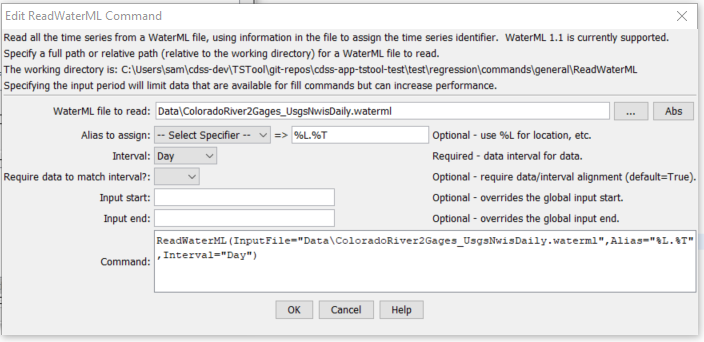TSTool / Command / ReadWaterML
Overview
The ReadWaterML command reads one or more time series from a WaterML XML time series file
(see the WaterML Input Type Appendix).
WaterML version 1.1 is supported. WaterML files can be created using the
ReadUsgsNwisDaily,
ReadUsgsNwisGroundwater,
ReadUsgsNwisInstantaneous,
ReadWaterOneFlow, and
WriteWaterML commands,
and can be saved from web sites that provide WaterML using the
WebGet command.
This command may be enhanced in the future to read a subset of the time series in the WatermL file
(currently all time series in the file are read), and additional WaterML versions may be supported.
See also the ReadWaterML2 command, which reads newer WaterML 2 format.
Command Editor
The following dialog is used to edit the command and illustrates the command syntax.

ReadWaterML Command Editor (see also the full-size image)
Command Syntax
The command syntax is as follows:
ReadWaterML(Parameter="Value",...)
Command Parameters
| Parameter | Description | Default |
|---|---|---|
InputFile |
The name of the WaterML file to read. The path to the file can be absolute or relative to the working directory. | None – must be specified. |
Alias |
The alias to assign to the time series, as a literal string or using the special formatting characters listed by the command editor. The alias is a short identifier used by other commands to locate time series for processing, as an alternative to the time series identifier (TSID). | No alias is assigned. |
Interval |
The data interval for the file, necessary because WaterML 1.1 does not have a data element indicating the interval (time step for the data) and using irregular by default would be inefficient for data management. This issue is being further evaluated. | None – must be specified. |
RequireDataToMatchInterval |
Indicate whether the date/time for each data value must align with the interval:
This parameter and the Interval parameter will continue to be evaluated. |
TrueParameter is not used for irregular data. |
InputStart |
The start of the period to read data – specify if the period should be different from the global query period. | Use the global query period. |
InputEnd |
The end of the period to read data – specify if the period should be different from the global query period. | Use the global query period. |
Examples
See the automated tests.
Troubleshooting
See Also
ReadUsgsNwisDailycommandReadUsgsNwisGroundwatercommandReadUsgsNwisInstantaneouscommandReadWaterML2commandReadWaterOneFlowcommandWebGetcommandWriteWaterMLcommand